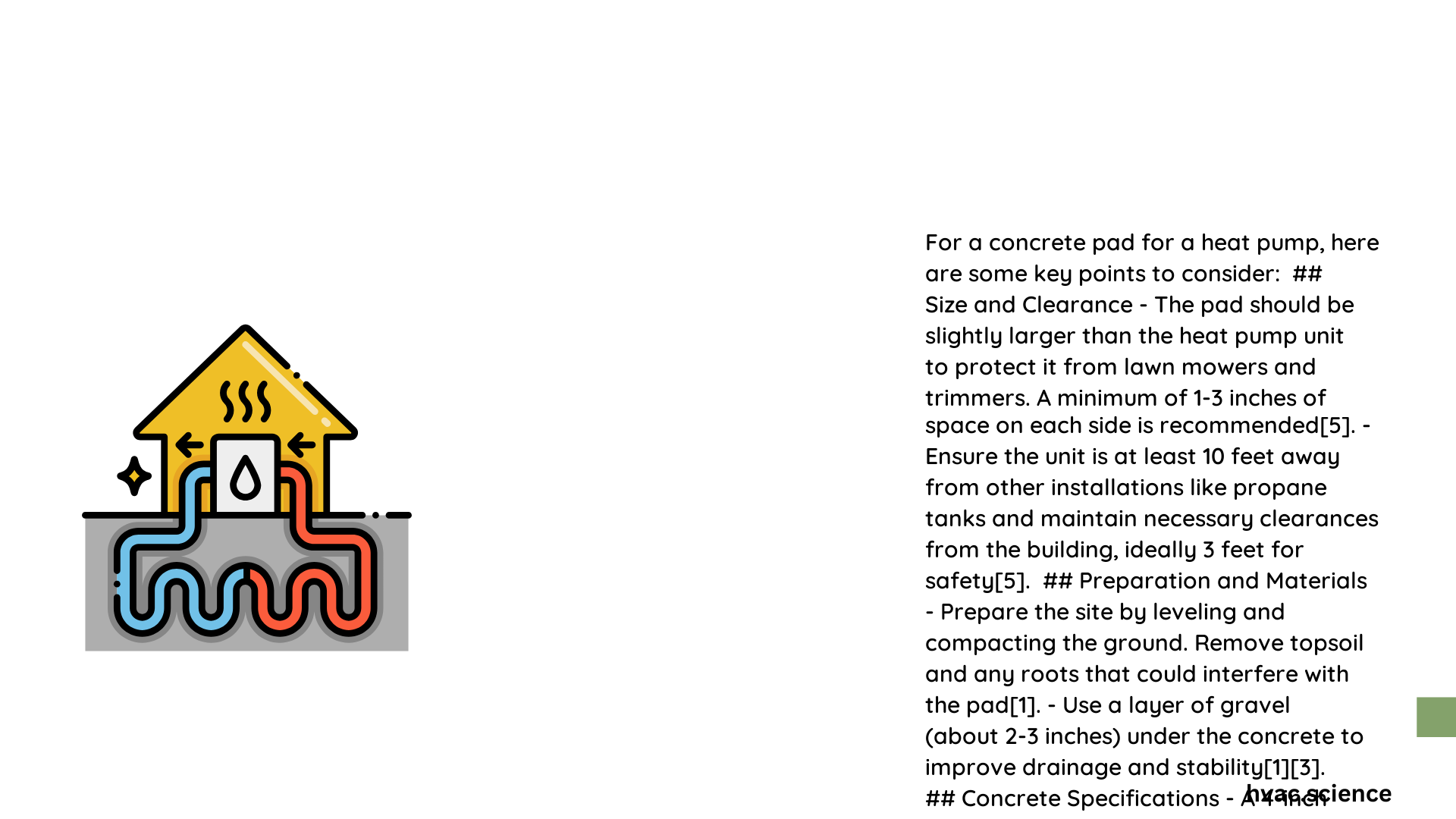A concrete pad for heat pump serves as a critical foundation that ensures stable, level, and protected placement of your heat pump unit. Proper installation involves precise site selection, appropriate dimensions, drainage considerations, and structural integrity to support the equipment’s weight and performance, ultimately protecting your significant HVAC investment from environmental challenges and potential damage.\n\n## What Makes a Concrete Pad Critical for Heat Pump Performance?\n\nA well-constructed concrete pad provides several essential benefits for heat pump installations:\n\n- Stability: Prevents unit tilting or sinking\n- Protection: Shields equipment from ground moisture\n- Airflow: Ensures proper ventilation around the unit\n- Longevity: Reduces wear and potential mechanical issues\n\n## How Large Should a Concrete Pad Be?\n\nStandard concrete pad dimensions vary based on heat pump specifications:\n\n| Heat Pump Size | Recommended Pad Dimensions | Thickness |\n|—————|—————————-|———-|\n| Small Units | 36 x 36 inches | 4 inches |\n| Medium Units | 38 x 42 inches | 4 inches |\n| Large Units | 48 x 48 inches | 6 inches |\n\n### Preparation Techniques for Concrete Pad Installation\n\n#### Site Selection Criteria\n\nWhen choosing a location for your concrete pad, consider these critical factors:\n\n1. Level ground surface\n2. Minimum 3 feet distance from building walls\n3. Good drainage area\n4. Away from potential landscaping damage\n5. Accessible for maintenance\n\n#### Ground Preparation Steps\n\n- Remove vegetation and debris\n- Compact soil thoroughly\n- Create slight grade for water drainage\n- Use gravel base for enhanced stability\n\n## What Materials Are Needed for Concrete Pad Construction?\n\nEssential materials include:\n\n- Portland cement\n- Coarse aggregate\n- Fine sand\n- Water\n- Rebar or wire mesh (optional reinforcement)\n- Wooden forms\n- Trowel\n- Level\n\n### Concrete Mix Recommendations\n\nTypical Concrete Mix Ratios:\n- 1 part cement\n- 2 parts sand\n- 3 parts aggregate\n\n## How to Ensure Proper Drainage?\n\nDrainage is crucial for heat pump concrete pad performance:\n\n- Create 1-2% slope away from unit\n- Use permeable underlayment\n- Consider gravel base\n- Prevent water accumulation\n\n## Weight Capacity Considerations\n\nFactor affecting concrete pad strength:\n- Standard residential concrete: 3000-4000 PSI\n- Reinforcement increases load-bearing capacity\n- Thickness impacts overall structural integrity\n\n## Climate-Specific Installation Tips\n\n### Cold Regions\n- Elevate pad to prevent snow buildup\n- Use frost-resistant concrete mix\n- Add extra insulation underneath\n\n### Hot/Humid Regions\n- Enhance drainage capabilities\n- Use reflective surface materials\n- Consider elevated installation\n\n## Maintenance Recommendations\n\n- Inspect annually for cracks\n- Clean surrounding area\n- Check level periodically\n- Remove debris\n\n## Professional vs. DIY Installation\n\n| Approach | Pros | Cons |\n|———-|——|——|\n| DIY | Cost-effective | Requires skill |\n| Professional | Guaranteed quality | Higher cost |\n\n## Final Recommendations\n\nInvest time in proper concrete pad preparation to ensure optimal heat pump performance and longevity. Consult local HVAC professionals for region-specific guidance.\n\n### Reference:\n- HVAC Installation Guidelines\n- Concrete Pad Standards

